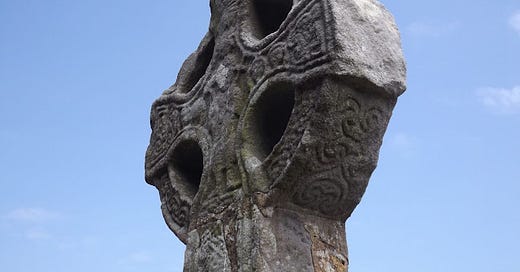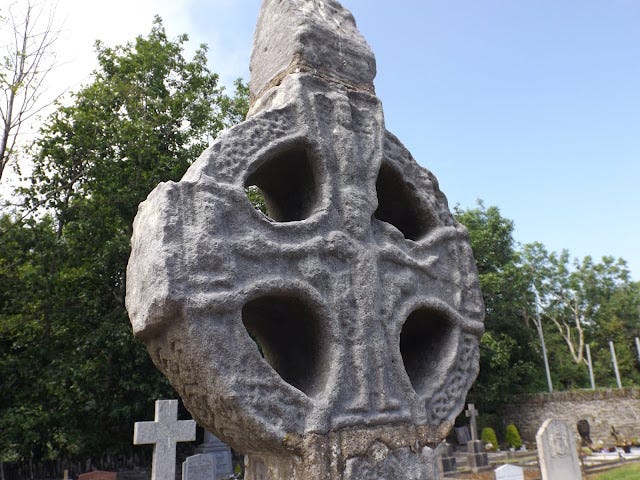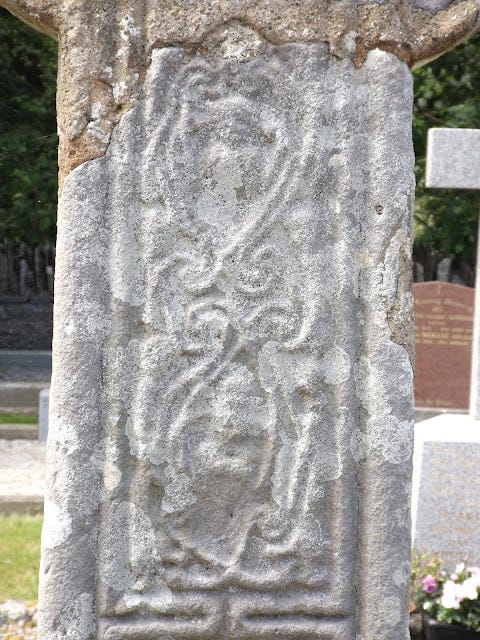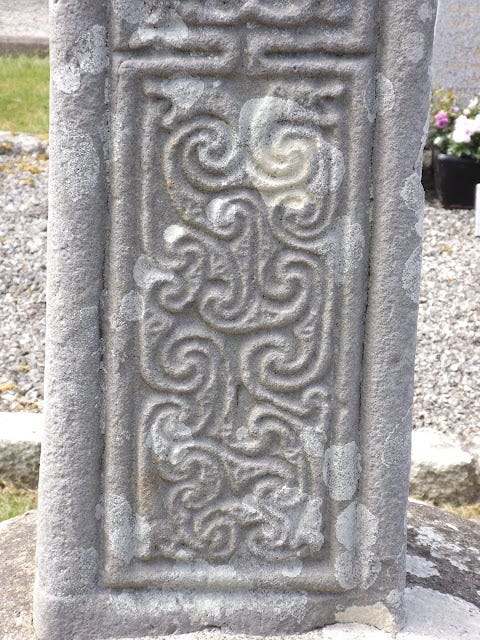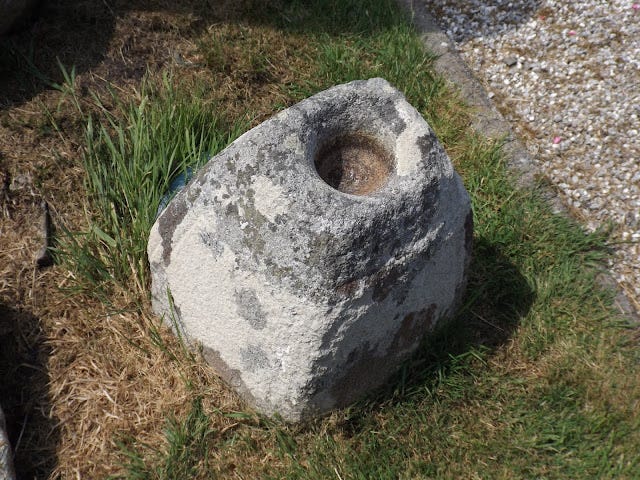Termonfeckin High Cross, Co. Louth
'Termonfeckin' is an anglicisation of 'Tearmann Feichin' which translates as 'sanctuary of Fechin'. St. Fechin established a monastery there in the 7th century
Termonfeckin is a small village located north of the Boyne between Drogheda and Clogherhead. Termonfeckin was originally a monastic site, indeed it takes its name from the patron who established the foundation, St. Fechin. 'Termonfeckin' is an anglicisation of Tearmann Feichin which translates as "sanctuary of Fechin".
St Fechin was born in approximately 580AD and he died from the plague in either 664 or 665, after a long and productive life during which he established numerous monastic foundations including that at Termonfeckin. His feast day is on the 20th January.
Known as St Fechin of Fore, his more famous foundations lie elsewhere (Fore in Westmeath, Cong in Mayo and High Island in Galway), but nonetheless, the foundation at Termonfeckin was an important one for hundreds of years after his death in the 7th Century. This is evidenced by the construction of the high cross around the 9th/10th Century. The monastery was raided by the Vikings and others on a number of occasions from the 10th Century onward, suggesting it was a place worth raiding! Termonfeckin High Cross is the main remnant of the monastic foundation today.
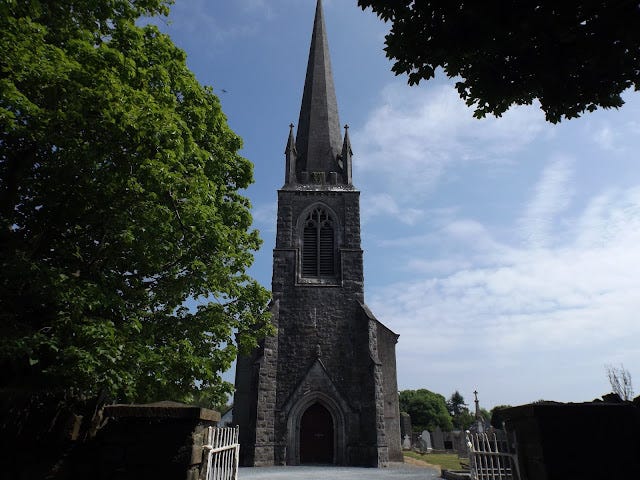
Today, the nucleus of the site remains as a graveyard surrounding an attractive, defunct protestant church. The graveyard contains a smattering of ancient slabs and a high cross, the topic of this article.

I have visited the high cross at Termonfeckin on a number of occasions over the past 18 months. My photographs are taken from these various visits. It is typical for all stone sculpture, but particularly this high cross, that lighting is everything when it comes to making out features. On some of my photographs features are barely distinguishable, on others, taken on different days with different lighting (Peter Harbison suggests between 14:00 and 16:00 on a summer's day), they leap out.
Termonfeckin high cross measures approximately 2.2 meters in height, (excluding the modern base), and is carved out of siliceous sandstone. The cross is somewhat smaller than is typical for high crosses in Ireland, which can measure as tall as 6 meters in height. It appears that the head was broken off and reattached at some point as visual evidence of such a repair is apparent.
As mentioned, the base of the cross, by all accounts, and indeed appearance, is not original and it seems the cross was remounted on this base in modern times. This theory is given further credence when one considers that on this cross the crucifixion depiction faces east, whereas it commonly tends to face west, suggesting that the cross was remounted facing the wrong way!
No one is sure of the exact reason why these crosses were built, but there are many suggestions: as status symbols, to mark territory, to educate the illiterate and as a Celtic alternative to the frescoes of continental Europe. Like frescoes, high crosses would have probably been painted, although no direct evidence of this has been uncovered. Objects of piety, the crosses served to lead the observer to contemplate the various Biblical scenes depicted, in particular the crucifixion of Christ (a bit like the 'Stations of the Cross' one finds in modern Churches) and the Last Judgement. The high cross at Termonfeckin follows this trend but Biblical depictions are confined to the east and west faces of the head of the cross rather than on the shaft also as can be found elsewhere.
The East Face of Termonfeckin High Cross
Below a gabled finial, the first figure depicted on the east face of the cross is that of an angel, with wings outstretched. The wings on this figure are quite large, being the same height as the angel's body.
The main depiction on the east face of the cross is the crucifixion of Christ, an event which, in medieval times, would have undoubtedly been viewed as the most important event in world history. As such, it takes center stage in many Irish high crosses.
On the crucified Christ's right-hand side we can see what looks like a pointed object, held by a figure, piercing the right side of Jesus' body. This appears to be a depiction of St. Longinus, the Roman soldier who pierced Jesus' side with a lance (John 19:37). Tradition has it that the blood and water spilled from Jesus cured St. Longinus of his sight problems, he became a Christian and was eventually martyred.
On Christ's left hand side things are much harder to make out, there appears to be some figure, probably Stephaton the Roman soldier who offered Jesus a sponge soaked in wine/vinegar. (There has historically been some debate as to what the sponge was soaked in, either vinegar to torture Jesus, or wine to sate Christ's cries of thirst). Stephaton and St. Longinus tend to be depicted together in iconography, with the proffering of the sponge and piercing with the lance occurring simultaneously.
Interestingly, on this cross Christ's feet appear to be tied to the cross rather than nailed, evidenced by the positioning of the feet and the narrow band (rope?) between them.
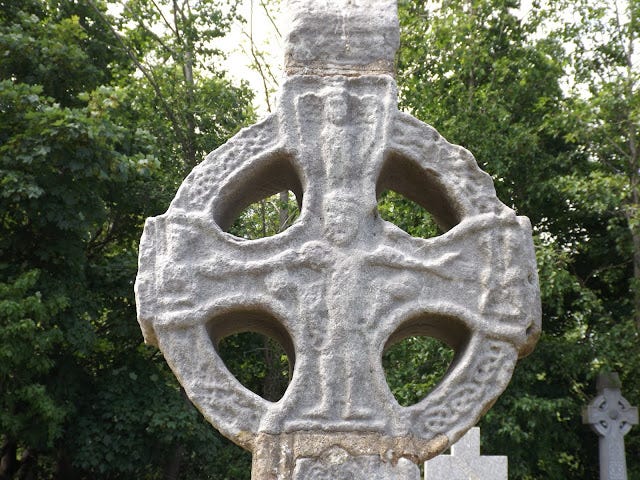
There are figures positioned at Christ's right and left hands. These depictions are much eroded and damaged making them very difficult to make out. Perhaps these depict Mary and St. Paul, or perhaps St. Peter and St. Paul, or a combination of all three. Or maybe something else entirely!
Moving down the east face of the cross to the shaft, we see two "panels" of interesting designs. The first features cherubs and spirals. Cherubs are angelic creatures, noted in several instances in the Bible, for example, they were set as guardians of the Garden of Eden.
The second panel features dragons and spirals. Two dragon heads can be seen at the top of the panel, facing away from one another.
The West Face of Termonfeckin High Cross
The west face of the cross is not as easily interpreted and recognised as the east. There are less clear figures on the west face, there may be a small figure of an angel above the central figure, but there is only one obvious figure on the west face of the cross, the one in the center of the cross head.
This carving depicts a figure holding a flowering scepter in his right hand and a cross staff in his left.There are differing accounts as to what the nature of the figure depicted is - almost all accounts, certainly modern scholarly opinion - agree that it is Christ. But there is some debate over what the context is, with some describing the depiction as being Christ in Glory/Christ in Majesty and others describing it as an abbreviated depiction of The Last Judgement.

Christ in Glory refers to the tradition of depicting Christ in triumphal attire and posture representing Christ's triumph in resurrection, dominion over the world and the redemption of man. The regal iconography of scepters and laurels is a triumphal theme evolved and continued on from that of late Roman art, where victorious generals and emperors etc. were depicted in similar fashion.
The Last Judgement refers to , of course, the ultimate judgment of man at the end of time, so excellently depicted on another Co. Louth cross, the famous Muiredach's Cross at Monasterboice.
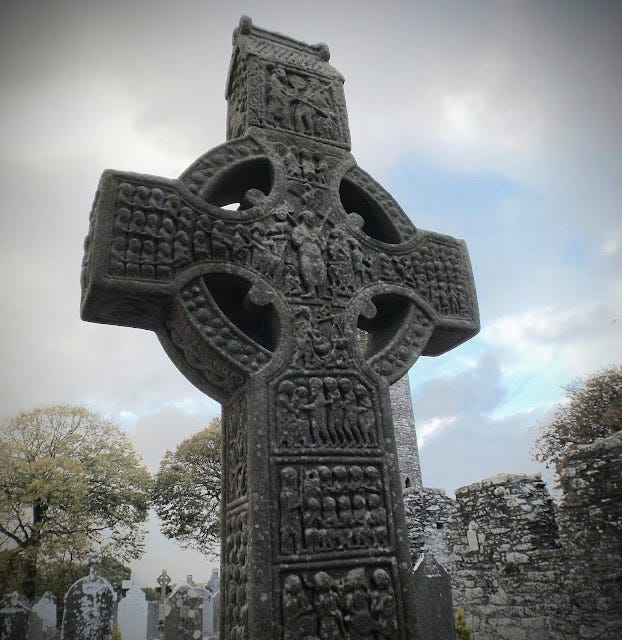
On either side of Christ can be seen what look like orbs. What exactly these are, we cannot completely make out. They appear to be heads, one theory goes that they are heads emerging from rounded arches, representing the cave tombs from which the dead will arise (The Catholic Church preached, and still does preach, that at the last reckoning, at the end of the world, the dead shall be resurrected to be publicly judged as part of a "general judgement" - to be distinguished from the immediate "individual judgement" upon death.), lending credence to the theory that the entire scene is to be regarded as a depiction of The Last Judgement.
Moving down the west face of the cross to the west shaft again there are two panels, the first features a much faded diagonal pattern.
The second panel contains a much clearer, and fairly intricate, interlacing pattern.
The North and South Sides
There are further intricate patterns on each side of the cross: interlace, fretwork and animals. However, due to poor lighting, I was unable to get decent pictures of these.
Concluding Thoughts
The high cross at Termonfeckin is very much worth visiting. While not as large or intricate as some others, it is nonetheless charming in its own right, my photographs don't quite do it justice. The location is charming also, the neo-gothic front of 19th Century Church is quite picturesque and the graveyard peaceful. There are also some interesting gravestones, a medieval slab with a depiction of the crucifixion, along with what appears to be the base of another high cross. There is also an old stone bridge built in 1799 and a fine tower house within walking distance. More on these another time!
With regard to the high cross, I have been somewhat handicapped in writing this article in that I do not have access to a library to check Peter Harbison's 3 Volume set on Irish high crosses which is regarded as the best work on the subject - once the Coronavirus situation is resolved I will check it - it may be that some of the questions posed above have already been answered!
References and Further Reading
Journal Articles
Notes on the High Crosses of Moone, Drumcliff, Termonfechin, and Killamery. (Plates XXVIII. to LI.), Margaret Stokes and T. J. Westropp, The Transactions of the Royal Irish Academy, Vol. 31 (1896/1901), pp. 541-578 (62 pages)
The Irish High Cross: Morphology and Iconography, Helen M. Roe, The Journal of the Royal Society of Antiquaries of Ireland, Vol. 95, No. 1/2, Papers in Honour of Liam Price (1965), pp. 213-226 (14 pages)
Townland Survey of County Louth (Continued), Donald Murphy, Journal of the County Louth Archaeological and Historical Society, Vol. 21, No. 4 (1988), pp. 398-406 (9 pages)
Other Blogposts/Websites
https://irishhighcrosses.com/dromiskin.html
http://irishantiquities.bravehost.com/louth/termonfeckin/termonfeckinHC.html
http://indigo.ie/~jdem/High%20Cross%20Termonfeckin.htm
http://www.megalithicireland.com/High%20Cross%20Termonfeckin.htm
Books
'Archaeological Inventory of County Louth' (Dublin: Stationery Office, 1986).
'Archaeological Survey of County Louth' (Dublin: Stationery Office, 1991).
Harbison, Peter, 'Irish High Crosses With the Figure Sculptures Explained' (The Boyne Valley Honey Company, 2013).
Harbison, Peter, 'Guide to National and Historic Monuments of Ireland' (Gill and Macmillan, 1992).
O'Brien, Jacqueline & Harbison, Peter, 'Ancient Ireland: From Prehistory to the Middle Ages' (George Weidenfeld & Nicolson, 1996).
Pochin Mould, Daphne D. C., 'The Irish Saints: Short Biographies of the Principal Irish Saints from the time of St. Patrick to that of St. Laurence O'Toole' (Clonmore and Reynolds Ltd, 1964).
Stout, Matthew, 'Early Medieval Ireland 431 - 1169' (Wordwell, 2017)

